Abstract
Enzymatic phosphorylation of amikacin has not been reported previously in gram-negative bacteria. We found that extracts of MP1, a mutant of Escherichia coli JR66/W677 that is resistant to amikacin, were able to phosphorylate this aminoglycoside more rapidly than were extracts of the parental strain. Conjugal transfer of resistance from MP1 to a recipient strain was accompanied by acquisition in the transconjugants of amikacin phosphotransferase activity and of a 57-megadalton plasmid present in the donor. Partial purification of the phosphotransferase activity on amikacin-Sepharose 4B yielded an enzyme with a substrate spectrum similar to that of the 3'-neomycin-kanamycin phosphotransferase II found E. coli, except that it was also active against amikacin. A mutant of MP1, MP5, had increased susceptibility to amikacin and reduced phosphotransferase activity. MP9, a mutant MP5, was more resistant to amikacin and had increased phosphotransferase activity. The mutations leading to these alterations of amikacin susceptibility and amikacin phosphotransferase activity were transferable with the same plasmid that was associated with amikacin resistance and phosphotransferase activity in MP1. These studies demonstrate that resistance to amikacin in a laboratory strain of E. coli is due to an aminoglycoside phosphotransferase coded by a transferable plasmid-borne gene.
Full text
PDF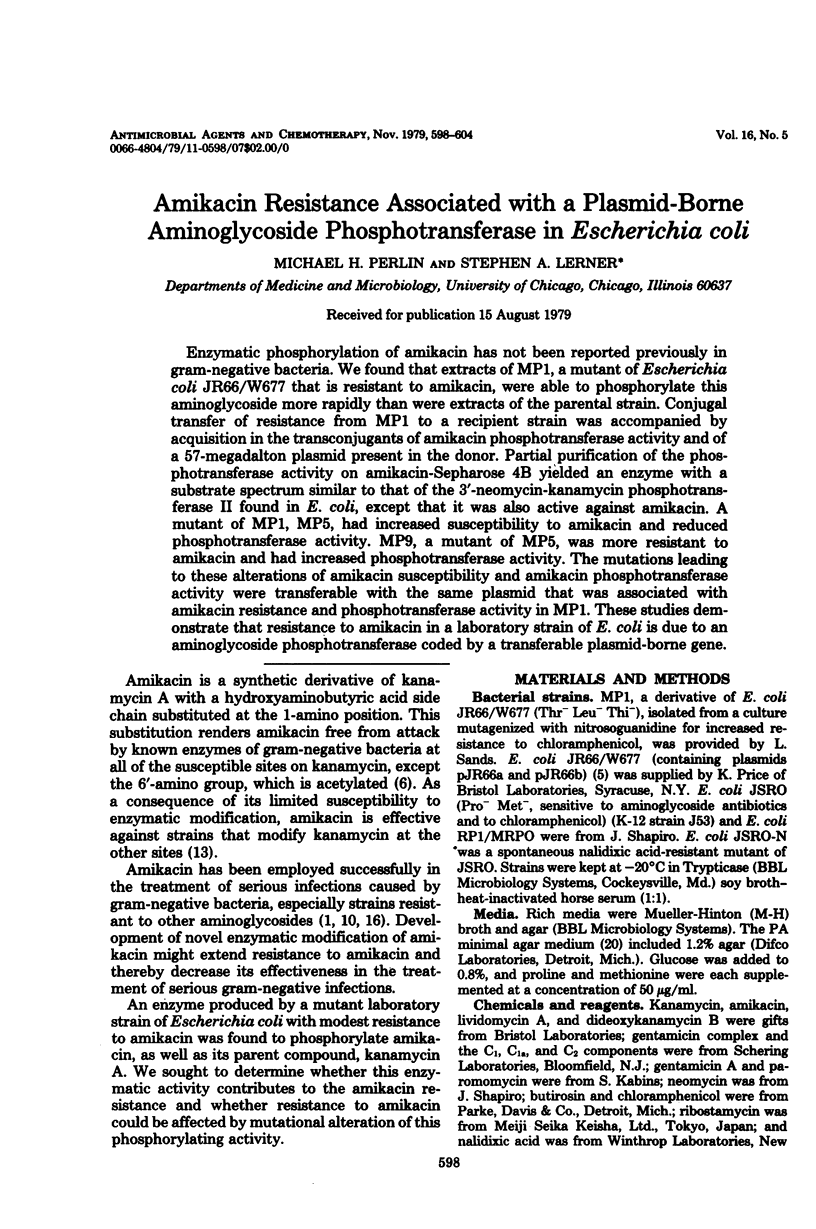
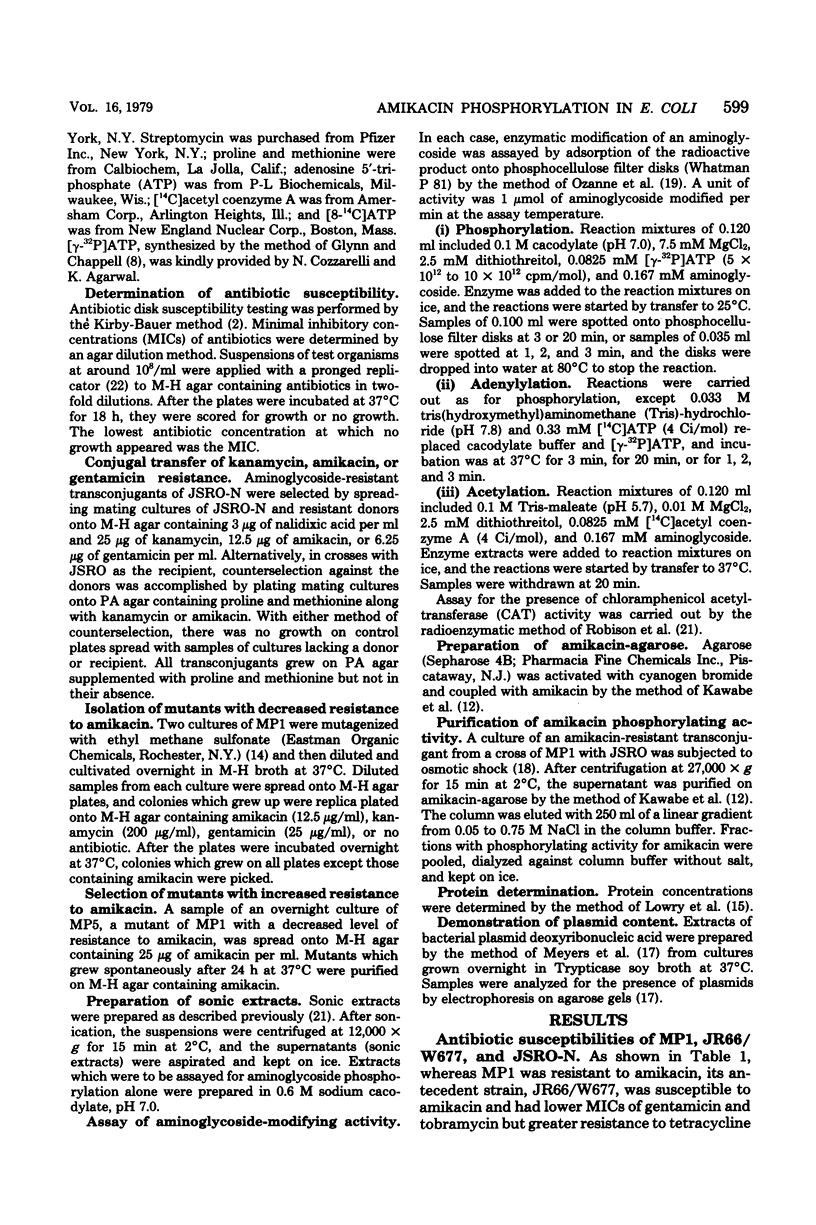
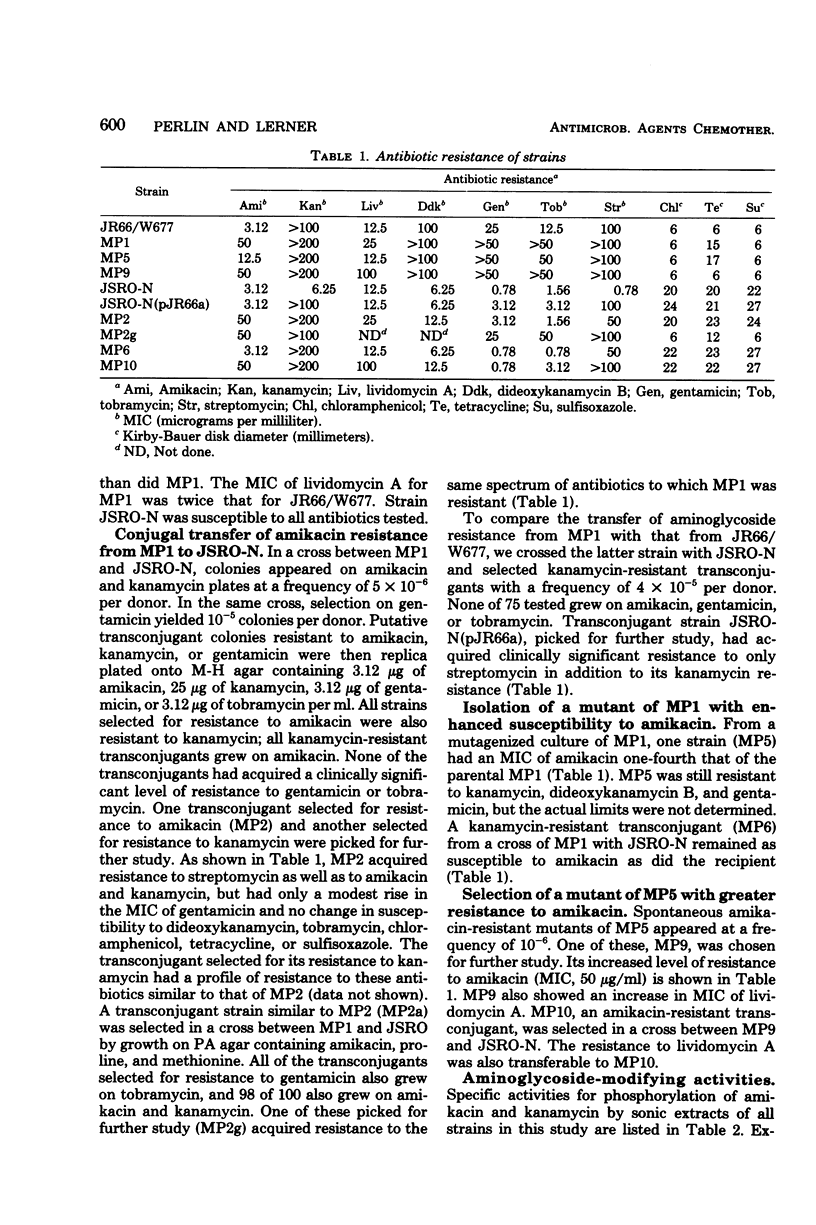
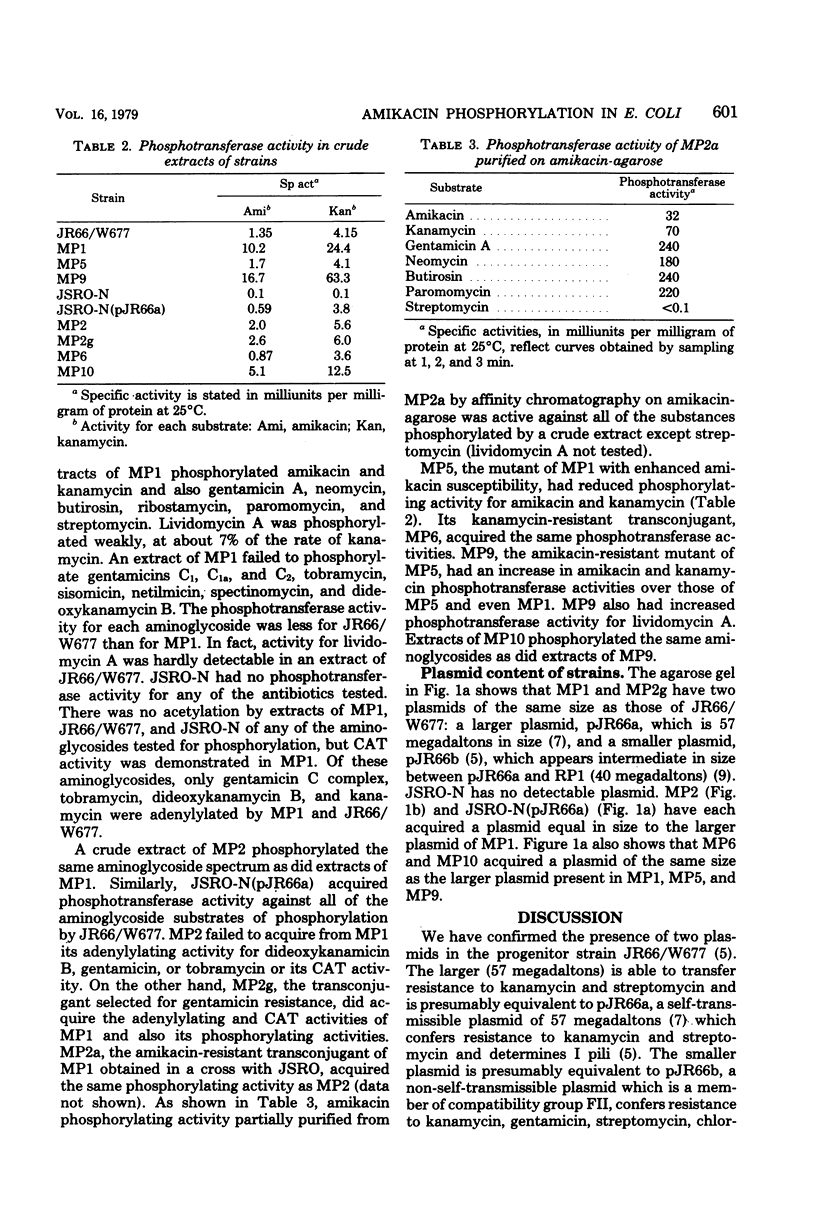
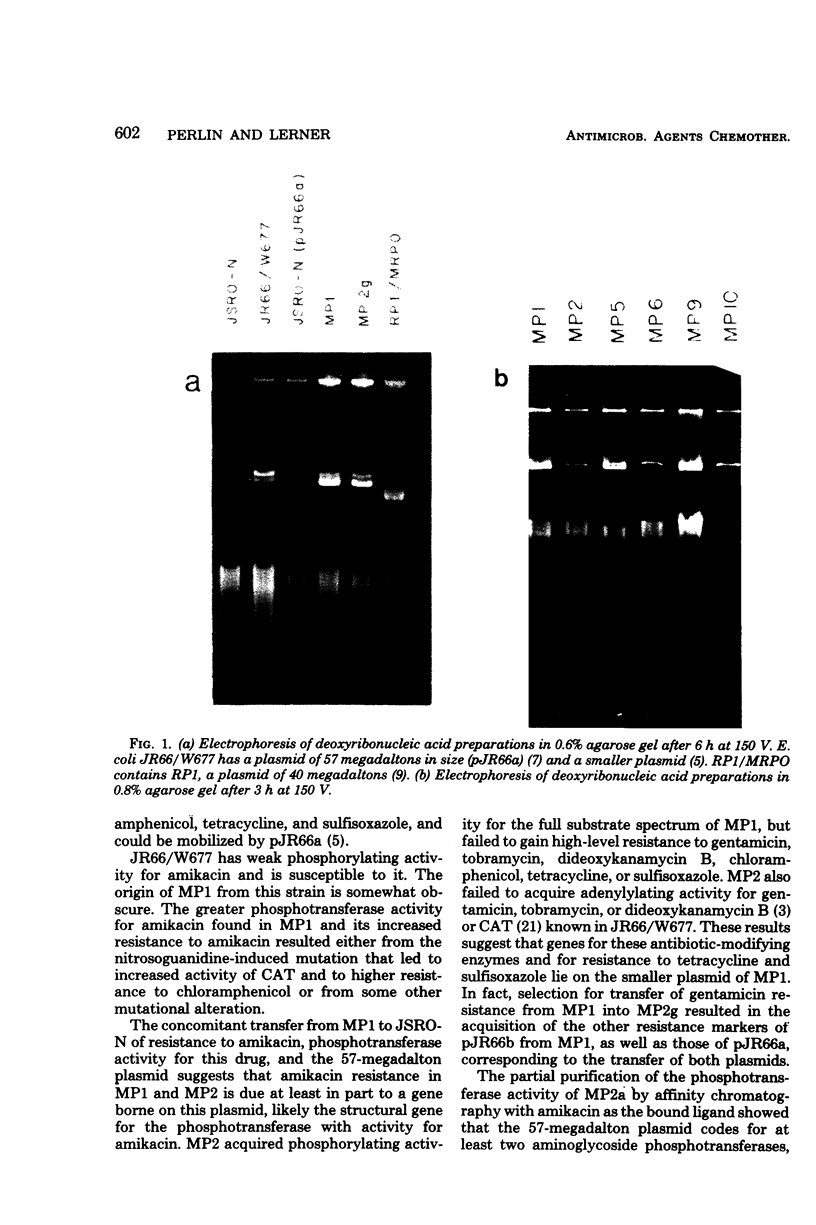
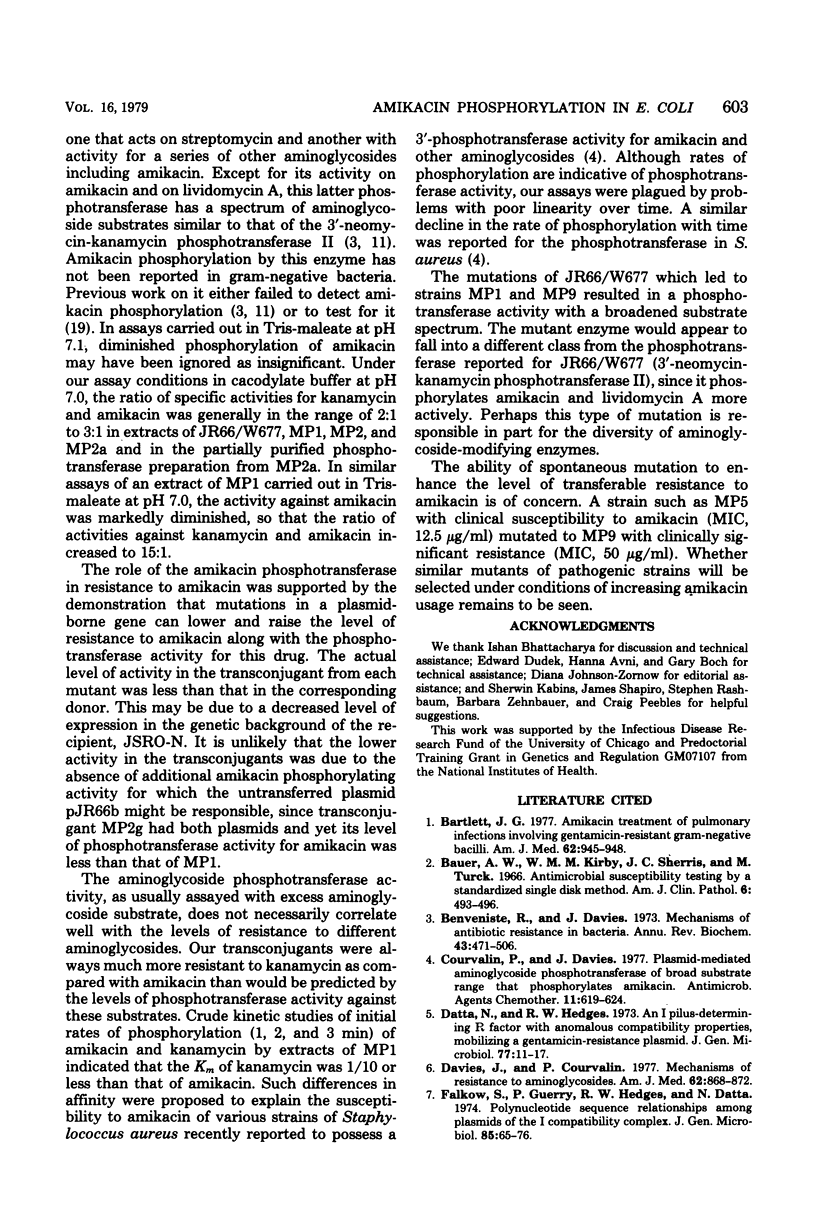
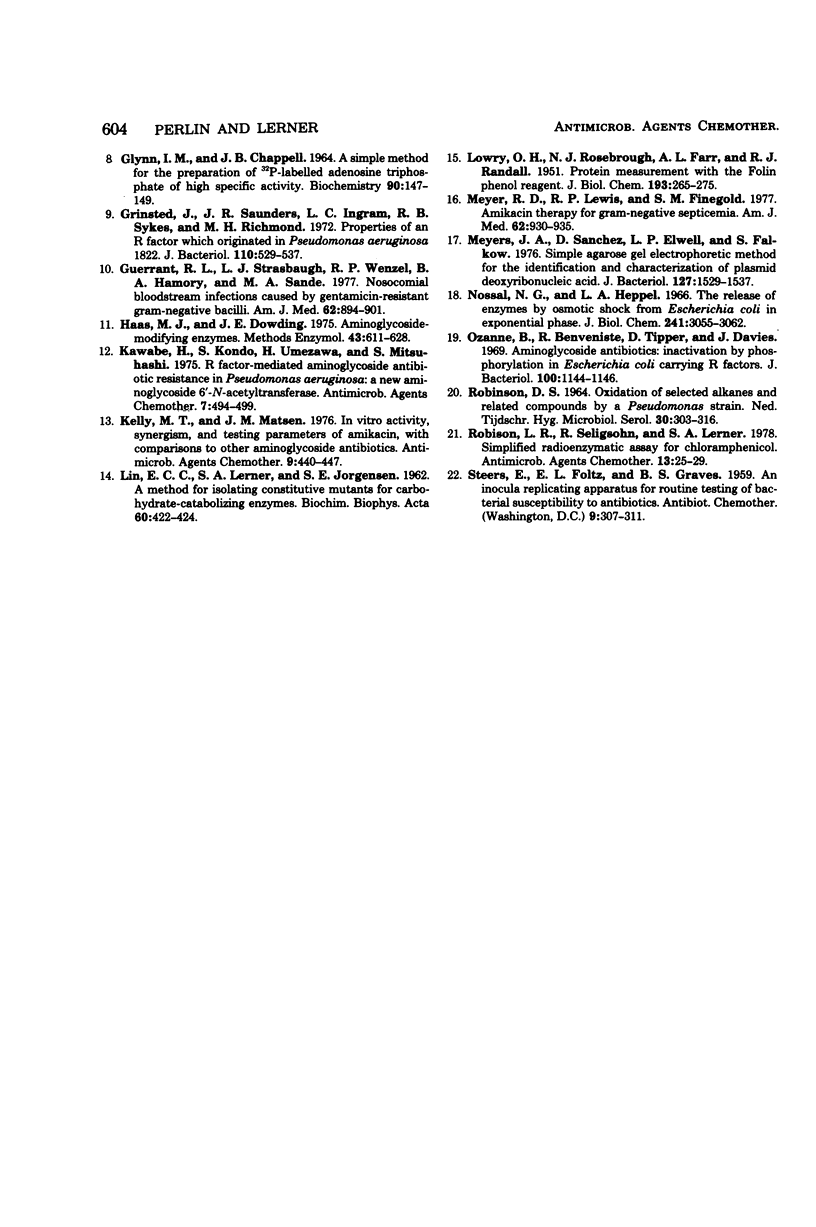
Images in this article
Selected References
These references are in PubMed. This may not be the complete list of references from this article.
- Bartlett J. G. Amikacin treatment of pulmonary infections involving gentamicin-resistant gram-negative bacilli. Am J Med. 1977 Jun;62(6):945–948. doi: 10.1016/0002-9343(77)90666-0. [DOI] [PubMed] [Google Scholar]
- Bauer A. W., Kirby W. M., Sherris J. C., Turck M. Antibiotic susceptibility testing by a standardized single disk method. Am J Clin Pathol. 1966 Apr;45(4):493–496. [PubMed] [Google Scholar]
- Benveniste R., Davies J. Mechanisms of antibiotic resistance in bacteria. Annu Rev Biochem. 1973;42:471–506. doi: 10.1146/annurev.bi.42.070173.002351. [DOI] [PubMed] [Google Scholar]
- Courvalin P., Davies J. Plasmid-medicated aminoglycoside phosphotransferase of broad substrate range that phosphorylates amikacin. Antimicrob Agents Chemother. 1977 Apr;11(4):619–624. doi: 10.1128/aac.11.4.619. [DOI] [PMC free article] [PubMed] [Google Scholar]
- Datta N., Hedges R. W. An I pilus-determining R factor with anomalous compatibility properties, mobilizing a gentamicin-resistance plasmid. J Gen Microbiol. 1973 Jul;77(1):11–17. doi: 10.1099/00221287-77-1-11. [DOI] [PubMed] [Google Scholar]
- Davies J., Courvalin P. Mechanisms of resistance to aminoglycosides. Am J Med. 1977 Jun;62(6):868–872. doi: 10.1016/0002-9343(77)90654-4. [DOI] [PubMed] [Google Scholar]
- Falkow S., Guerry P., Hedges R. W., Datta N. Polynucleotide sequence relationships among plasmids of the I compatibility complex. J Gen Microbiol. 1974 Nov;85(1):65–76. doi: 10.1099/00221287-85-1-65. [DOI] [PubMed] [Google Scholar]
- Glynn I. M., Chappell J. B. A simple method for the preparation of 32-P-labelled adenosine triphosphate of high specific activity. Biochem J. 1964 Jan;90(1):147–149. doi: 10.1042/bj0900147. [DOI] [PMC free article] [PubMed] [Google Scholar]
- Grinsted J., Saunders J. R., Ingram L. C., Sykes R. B., Richmond M. H. Properties of a R factor which originated in Pseudomonas aeruginosa 1822. J Bacteriol. 1972 May;110(2):529–537. doi: 10.1128/jb.110.2.529-537.1972. [DOI] [PMC free article] [PubMed] [Google Scholar]
- Guerrant R. L., Strausbaugh L. J., Wenzel R. P., Hamory B. H., Sande M. A. Nosocomial bloodstream infections caused by gentamicin-resistant gram-negative bacilli. Am J Med. 1977 Jun;62(6):894–901. doi: 10.1016/0002-9343(77)90658-1. [DOI] [PubMed] [Google Scholar]
- Haas M. J., Dowding J. E. Aminoglycoside-modifying enzymes. Methods Enzymol. 1975;43:611–628. doi: 10.1016/0076-6879(75)43124-x. [DOI] [PubMed] [Google Scholar]
- Kawabe H., Kondo S., Umezawa H., Mitsuhashi S. R factor-mediated aminoglycoside antibiotic resistance in Pseudomonas aeruginosa: a new aminoglycoside 6'-N-acetyltransferase. Antimicrob Agents Chemother. 1975 May;7(5):494–499. doi: 10.1128/aac.7.5.494. [DOI] [PMC free article] [PubMed] [Google Scholar]
- Kelly M. T., Matsen J. M. In vitro activity, synergism, and testing parameters of amikacin, with comparisons to other aminoglycoside antibiotics. Antimicrob Agents Chemother. 1976 Mar;9(3):440–447. doi: 10.1128/aac.9.3.440. [DOI] [PMC free article] [PubMed] [Google Scholar]
- LIN E. C., LERNER S. A., JORGENSEN S. E. A method for isolating constitutive mutants for carbohydrate-catabolizing enzymes. Biochim Biophys Acta. 1962 Jul 2;60:422–424. doi: 10.1016/0006-3002(62)90423-7. [DOI] [PubMed] [Google Scholar]
- LOWRY O. H., ROSEBROUGH N. J., FARR A. L., RANDALL R. J. Protein measurement with the Folin phenol reagent. J Biol Chem. 1951 Nov;193(1):265–275. [PubMed] [Google Scholar]
- Meyer R. D., Lewis R. P., Finegold S. M. Amikacin therapy for gram-negative septicemia. Am J Med. 1977 Jun;62(6):930–935. doi: 10.1016/0002-9343(77)90663-5. [DOI] [PubMed] [Google Scholar]
- Meyers J. A., Sanchez D., Elwell L. P., Falkow S. Simple agarose gel electrophoretic method for the identification and characterization of plasmid deoxyribonucleic acid. J Bacteriol. 1976 Sep;127(3):1529–1537. doi: 10.1128/jb.127.3.1529-1537.1976. [DOI] [PMC free article] [PubMed] [Google Scholar]
- Nossal N. G., Heppel L. A. The release of enzymes by osmotic shock from Escherichia coli in exponential phase. J Biol Chem. 1966 Jul 10;241(13):3055–3062. [PubMed] [Google Scholar]
- Ozanne B., Benveniste R., Tipper D., Davies J. Aminoglycoside antibiotics: inactivation by phosphorylation in Escherichia coli carrying R factors. J Bacteriol. 1969 Nov;100(2):1144–1146. doi: 10.1128/jb.100.2.1144-1146.1969. [DOI] [PMC free article] [PubMed] [Google Scholar]
- ROBINSON D. S. OXIDATION OF SELECTED ALKANES AND RELATED COMPOUNDS BY A PSEUDOMONAS STRAIN. Antonie Van Leeuwenhoek. 1964;30:303–316. doi: 10.1007/BF02046736. [DOI] [PubMed] [Google Scholar]
- Robison L. R., Seligsohn R., Lerner S. A. Simplified radioenzymatic assay for chloramphenicol. Antimicrob Agents Chemother. 1978 Jan;13(1):25–29. doi: 10.1128/aac.13.1.25. [DOI] [PMC free article] [PubMed] [Google Scholar]



